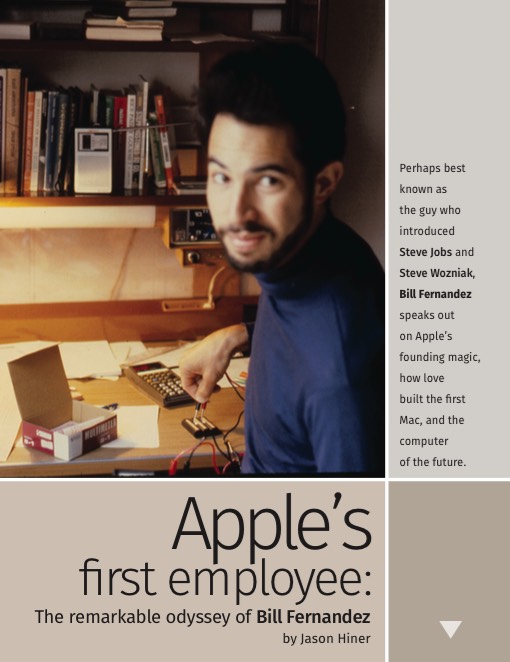The UI of the future: Three takeaways from Apple pioneer Bill Fernandez

When it comes user interface design, Bill Fernandez is one of the world's top brains. He grew up along side Steve Jobs and Steve Wozniak and was Apple's first employee. The stuff he worked on at Apple shaped the personal computer revolution, the graphical user interface, online video (from his work on QuickTime), and the rise of the web (from his work on HyperCard).
I recently wrote about Fernandez's remarkable career journey in an in-depth article on TechRepublic. While that piece focuses on the Fernandez story, it also contains nuggets of wisdom about UI design and some valuable perspective on the next generation of interfaces. For those who are especially interested in that stuff, I thought I'd break it down over here on ZDNet. Here are the three big takeaways:
1. Flat design needs to remember users

"We are in a time of transition," said Fernandez. "And like [how] the water becomes brackish where river water meets the ocean, the state of UI design is messy. There's some great stuff out there, much more than there used to be, but there's still a lot of trash, and there's a lot of well-meaning but misguided efforts. One example of this is in the migration from three-dimensional, photo-realistic UI elements (window frames, pushbuttons, sliders, etc.) to 'flat' UI design. Years ago a friend asked what I thought web pages of the future would be like and I said 'like magazines.' I thought we'd see flatter designs, expert typography, beautiful, magazine-advertisement-like page layouts, etc. That prediction is coming true...
"But in moving towards flat design we are losing much of the wisdom that was embedded in the old 3D style of UI. For example: A user must be able to glance at a screen and know what is an interactive element (e.g., a button or link) and what is not (e.g., a label or motto); A user must be able to tell at a glance what an interactive element does (does it initiate a process, link to another page, download a document, etc.?); The UI should be explorable, discoverable, and self-explanatory. But many apps and websites, in the interest of a clean, spartan visual appearance, leave important UI controls hidden until the mouse hovers over just the right area or the app is in just the right state. This leaves the user in the dark, often frustrated and disempowered."
2. Minority Report-style touchscreens aren't a thing
"The idea of having the transparent panels like you see on Minority Report and Iron Man and Avatar are for the most part, impractical," said Fernandez. "By waving your arms, you don't get any precision. Tony Stark in Iron Man, he's designing things. In real life, he'd have to spend hours drawing schematics, making precise mechanical diagrams, and there's no way you're going to do that in the air waving your hands. Your arms are going to become tired. So that's not really practical. It looks really good on the screen when you can take the camera through one of these displays to a person... But in real life people don't actually have that stuff...
3. The multi-modal UI of the future is on the way
"Years before Google announced their Glass project I used to paint this picture of the future: We will see a time when folks will be sitting in Starbucks gazing off into the distance, twitching their heads, waving their hands in mystical-looking incantations, and muttering to themselves," Fernandez said. "Why? Because they will have projectors projecting virtual data screens into their eyes... There will be a seamless, multi-modal UI experience using sight, sound, voice, head motion, arm movement, gestures, typing on virtual keyboards, etc. There have been pieces of this in research for decades. Only now are we beginning to see some of these things emerge into the consumer market: with Google Glass, Siri, etc. We have further to go, but we're on the road."
Read TechRepublic's cover story: Apple's first employee: The remarkable odyssey of Bill Fernandez
ZDNet's Monday Morning Opener is our opening salvo for the week in tech. As a global site, this editorial publishes on Monday at 8am AEST in Sydney, Australia, which is 6pm Eastern Time on Sunday in the US. It is written by a member of ZDNet's global editorial board, which is comprised of our lead editors across Asia, Australia, Europe, and the US.
Previously on Monday Morning Opener:
- Everyone wants to reinvent email, workflow: Here's what we really need
- Windows 10: Three things it has to do to succeed
- AWS re:Invent 2014: Cloud competition from Azure, Google scales
- iPhone 6: Coming from behind to unleash the next killer feature in mobile
- Surface versus iPad: A tale of two tablets?
- For enterprise, mobile devices about to become irrelevant
- Why I bought a $10 band instead of waiting for the Apple Watch
- Smartphones and loyalty: Hardware is still the heart of the matter
- Can Apple help drag banking into the modern age?
- The future of tech jobs: 5 themes to watch